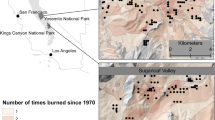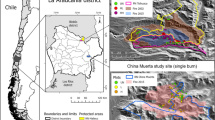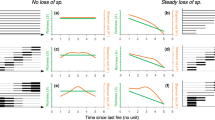Abstract
Understanding the response of understory vegetation to fire disturbance is vital to biodiversity conservation and management of boreal forests. We surveyed understory vascular plant richness and composition, and measured related environmental variables along a toposequence within three successional stages, initial (3 years post-fire), early (13 years post-fire) and late (>100 years post-fire) successional stages. Using permutation multivariate ANOVA and nonmetric multidimensional scaling, we analyzed how understory species richness and composition change as time-since-fire proceeds, and their correlative relationships with environmental variables. Species richness and composition showed significant differences among the three successional stages. Understory species richness and abundance were significantly associated with time-since-fire, topographic position, elevation and organic layer depth. Among these variables, time-since-fire had the strongest effect and topographic position was the second major factor on affecting understory community assembly. In addition, time-since-fire overwhelmed the effects of soil pH in the initial successional stage and gravimetric soil moisture in early and late successional stages on understory species composition
Similar content being viewed by others
References
Anderson MJ (2001) A new method for non-parametric multivariate analysis of variance. Austral Ecology 26(1): 32–46. DOI: 10.1111/j.1442-9993.2001.01070.pp.x
Arocena J, Opio C (2003) Prescribed fire-induced changes in properties of sub-boreal forest soils. Geoderma 113(1): 1–16. DOI: 10.1016/S0016-7061(02)00312-9
Azeria ET, Bouchard M, Pothier D, et al. (2011) Using biodiversity deconstruction to disentangle assembly and diversity dynamics of understorey plants along post -fire succession in boreal forest. Global Ecology and Biogeography 20(1): 119–133. DOI: 10.1111/j.1466-8238.2010.00580.x
Bond-Lamberty B, Peckham SD, Gower ST, et al. (2009) Effects of fire on regional evapotranspiration in the central Canadian boreal forest. Global Change Biology 15(5): 1242–1254. DOI: 10.1111/j.1365-2486.2008.01776.x
Brais S, Camiré C, Bergeron Y, et al. (1995) Changes in nutrient availability and forest floor characteristics in relation to stand age and forest composition in the southern part of the boreal forest of northwestern Quebec. Forest Ecology and Management 76(1): 181–189. DOI: 10.1016/0378-1127(95)03 541-H
Brais S, David P, Ouimet R (2000) Impacts of wild fire severity and salvage harvesting on the nutrient balance of jack pine and black spruce boreal stands. Forest Ecology and Management 137(1): 231–243. DOI: 10.1016/S0378-1127(99) 00331-x
Burton JI, Mladenoff DJ, Clayton MK, et al. (2011) The roles of environmental filtering and colonization in the fine-scale spatial patterning of ground -layer plant communities in north temperate deciduous forests. Journal of Ecology 99(3): 764–776. DOI: 10.1111/j.1365-2745.2011.01807.x
Cerdá A, Doerr SH (2005) Influence of vegetation recovery on soil hydrology and erodibility following fire: an 11-year investigation. International Journal of Wildland Fire 14(4): 423–437. DOI: 10.1071/WF05044
Certini G (2005) Effects of fire on properties of forest soils: a review. Oecologia 143(1): 1–10. DOI 10.1007/s00442-004-1788-8
Chang Y, He HS, Bishop I, et al. (2007) Long-term forest landscape responses to fire exclusion in the Great Xing’an Mountains, China. International Journal of Wildland Fire 16(1): 34–44. DOI: 10.1071/WF05093
Chapin FS, Bret-Harte MS, Hobbie SE, et al. (1996) Plant functional types as predictors of transient responses of arctic vegetation to global change. Journal of Vegetation Science 7(3): 347–358. DOI: 10.2307/3236278
Chipman SJ, Johnson E (2002) Understory vascular plant species diversity in the mixedwood boreal forest of western Canada. Ecological Applications 12(2): 588–601. DOI: 10.1890/1051-0761(2002)012[0588:UVPSDI]2.0.CO;2
Connell JH, Slatyer RO (1977) Mechanisms of succession in natural communities and their role in community stability and organization. American Naturalist 111(982): 1119–1144. DOI: 10.1086/283241
Cornwell WK, Schwilk DW, Ackerly DD (2006) A trait-based test for habitat filtering: convex hull volume. Ecology 87(6): 1465–1471. DOI: 10.1890/0012-9658(2006)87[1465:ATTFHF] 2.0. CO;2
De Grandpre L, Bergeron Y (1997) Diversity and stability of understorey communities following disturbance in the southern boreal forest. Journal of Ecology: 777–784. DOI: 10.2307/2960601
Diamond JM (1975) Assembly of species communities. Ecology and Evolution of Communities 342: 444.
Fu P (1995) Clavis Plantarum Chinae Boreali-Orientalis (In Chinese with Latin Name Index). Science press, Beijing, China.
Gilliam FS (2007) The ecological significance of the herbaceous layer in temperate forest ecosystems. Bioscience 57(10): 845–858. DOI: 10.1641/b571007
Gong Z (2001) Chinese Soil Taxonomy. Science Press, Beijing, China. (In Chinese)
Grandpré L, Gagnon D, Bergeron Y (1993) Changes in the understory of Canadian southern boreal forest after fire. Journal of Vegetation Science 4(6): 803–810. DOI: 10.2307/3235618
Greene D, Zasada JC, Sirois L, et al. (1999) A review of the regeneration dynamics of North American boreal forest tree species. Canadian Journal of Forest Research 29(6): 824–839. DOI: 10.1139/x98-112
Griffiths RP, Madritch MD, Swanson AK (2009) The effects of topography on forest soil characteristics in the Oregon Cascade Mountains (USA): Implications for the effects of climate change on soil properties. Forest Ecology and Management 257(1): 1–7. DOI: 10.1016/j.foreco.2008.08.010
Halpern CB, Evans SA, Nielson S (1999) Soil seed banks in young, closed-canopy forests of the Olympic Peninsula, Washington: potential contributions to understory reinitiation. Canadian Journal of Botany 77(7): 922–935. DOI: 10.1139/b99-085
Halpern CB, Lutz JA (2013) Canopy closure exerts weak controls on understory dynamics: a 30-year study of overstory-understory interactions. Ecological Monographs 83(2): 221–237. DOI: 10.1890/12-1696.1
Hart SA, Chen HY (2006) Understory vegetation dynamics of North American boreal forests. Critical Reviews in Plant Sciences 25(4): 381–397. DOI: 10.1080/07352680600819286
Hart SA, Chen HY (2008) Fire, logging, and overstory affect understory abundance, diversity, and composition in boreal forest. Ecological Monographs 78(1): 123–140. DOI: 10.1890/06-2140.1
Hautala H, Tolvanen A, Nuortila C (2001) Regeneration strategies of dominant boreal forest dwarf shrubs in response to selective removal of understorey layers. Journal of Vegetation Science 12(4): 503–510. DOI: 10.2307/3237002
Hollingsworth T, Walker M, Chapin III F, et al. (2006) Scaledependent environmental controls over species composition in Alaskan black spruce communities. Canadian Journal of Forest Research 36(7): 1781–1796. DOI: 10.1139/x06-061
Hollingsworth TN, Johnstone JF, Bernhardt EL, et al. (2013) Fire severity filters regeneration traits to shape community assembly in Alaska’s boreal forest. PloS one 8(2): e56033. DOI: 10.1371/journal.pone.0056033
Hubbell SP (2001) The unified neutral theory of biodiversity and biogeography. Princeton University Press, Princeton, USA.
Huffman EL, MacDonald LH, Stednick JD (2001) Strength and persistence of fire -induced soil hydrophobicity under ponderosa and lodgepole pine, Colorado Front Range. Hydrological Processes 15(15): 2877–2892. DOI: 10.1002/hyp.379
Kasischke ES, Johnstone JF (2005) Variation in postfire organic layer thickness in a black spruce forest complex in interior Alaska and its effects on soil temperature and moisture. Canadian Journal of Forest Research 35(9): 2164–2177. DOI: 10.1139/x05-159
Kasischke ES, O’Neill KP, French NH, et al. (2000) Fire, climate change, and carbon cycling in the boreal forest. Spriger-Verlag: New York, USA, 173–196.
Kerns BK, Thies WG, Niwa CG (2006) Season and severity of prescribed burn in ponderosa pine forests: implications for understory native and exotic plants. Ecoscience 13(1): 44–55. DOI: 10.2980/1195-6860(2006)13[44:SASOPB]2.0.CO;2
Kloke JD, McKean JW (2012) Rfit: Rank-based estimation for linear models. The R Journal 4(2): 57–64.
Kong J-j, Yang J, Chu H, et al. (2015) Effects of wildfire and topography on soil nitrogen availability in a boreal larch forest of northeastern China. International Journal of Wildland Fire 24(3): 433–442. DOI: 10.1071/WF13218
Kruskal JB, Wish M (1978) Multidimensional scaling. Sage publications, London, UK.
Lebrija-Trejos E, Pérez-García EA, Meave JA, et al. (2010) Functional traits and environmental filtering drive community assembly in a species-rich tropical system. Ecology 91(2): 386–398. DOI: 10.1890/08-1449.1
Lynham T, Wickware G, Mason J (1998) Soil chemical changes and plant succession following experimental burning in immature jack pine. Canadian Journal of Soil Science 78(1): 93–104. DOI: 10.4141/S97-031
McCune B, Grace JB, Urban DL (2002) Analysis of ecological communities. MjM software design, Oregon, USA.
Neary DG, Klopatek CC, DeBano LF, et al. (1999) Fire effects on belowground sustainability: a review and synthesis. Forest ecology and management 122(1): 51–71. DOI: 10.1016/S0378-1127(99)00032-8
Nilsson MC, Wardle DA (2005) Understory vegetation as a forest ecosystem driver: evidence from the northern Swedish boreal forest. Frontiers in Ecology and the Environment 3(8): 421–428. DOI: 10.1890/1540-9295(2005)003[0421:UVAAFE]2.0.CO;2
Oksanen J, Kindt R, Legendre P, et al. (2007) The vegan package. Community ecology package 10: 631–637.
Paré D, Bergeron Y (1996) Effect of colonizing tree species on soil nutrient availability in a clay soil of the boreal mixedwood. Canadian Journal of Forest Research 26(6): 1022–1031. DOI: 10.1139/x26-113
R Development Core Team (2014) R: A language and environment for statistical computing. R Foundation for Statistical Computing, Vienna, Austria.
Rees DC, Juday GP (2002) Plant species diversity on logged versus burned sites in central Alaska. Forest Ecology and Management 155(1): 291–302. DOI: 10.1016/S0378-1127(01) 00566-7
Robichaud PR (2000) Fire effects on infiltration rates after prescribed fire in Northern Rocky Mountain forests, USA. Journal of Hydrology 231: 220–229. DOI: 10.1016/S0022-1694(00)00196-7
Seibert J, Stendahl J, Sørensen R (2007) Topographical influences on soil properties in boreal forests. Geoderma 141(1): 139–148. DOI: 10.1016/j.geoderma.2007.05.013
Shakesby R, Chafer C, Doerr S, et al. (2003) Fire severity, water repellency characteristics and hydrogeomorphological changes following the Christmas 2001 Sydney forest fires. Australian Geographer 34(2): 147–175. DOI: 10.1080/00049180301736
Shropshire C, Wagner RG, Bell FW, et al. (2001) Light attenuation by early successional plants of the boreal forest. Canadian Journal of Forest Research 31(5): 812–823. DOI: 10.1139/x01-006
Simard D, Fyles J, Paré D, et al. (2001) Impacts of clearcut harvesting and wildfire on soil nutrient status in the Quebec boreal forest. Canadian Journal of Soil Science 81(2): 229–237. DOI: 10.4141/S00-028
Stark KE, Arsenault A, Bradfield GE (2006) Soil seed banks and plant community assembly following disturbance by fire and logging in interior Douglas-fir forests of south-central British Columbia. Botany 84(10): 1548–1560. DOI: 10.1139/b06-112
Ulery A, Graham R, Amrhein C (1993) Wood-ash composition and soil pH following intense burning. Soil Science 156(5): 358–364.
Uotila A, Kouki J (2005) Understorey vegetation in sprucedominated forests in eastern Finland and Russian Karelia: Successional patterns after anthropogenic and natural disturbances. Forest Ecology and Management 215(1): 113–137. DOI: 10.1016/j.foreco.2005.05.008
Walker LR, Wardle DA, Bardgett RD, et al. (2010) The use of chronosequences in studies of ecological succession and soil development. Journal of Ecology 98(4): 725–736. DOI: 10.1111/j.1365-2745.2010.01664.x
Wang C, Gower ST, Wang Y, et al. (2001) The influence of fire on carbon distribution and net primary production of boreal Larix gmelinii forests in north-eastern China. Global Change Biology 7(6): 719–730.DOI:10.1046/j.1354-1013.2001.00441.x
Weiher E, Keddy P (2001) Ecological assembly rules: perspectives, advances, retreats. Cambridge University Press, Cambridge, UK.
Zhou Y (1991) Vegetation of Da Hinggan Ling in China. Science press, Beijing, China. (In Chinese)
Acknowledgments
This research was funded by the National Natural Science Foundation of China (Grant Nos. 31270511, 41501200). The authors thank Huzhong Forestry Bureau and Huzhong Natural Reserve for the help in field investigations. We thank the editor and two anonymous reviewers for their constructive comments, which helped us to improve the manuscript.
Author information
Authors and Affiliations
Corresponding author
Additional information
http://orcid.org/0000-0001-6098-4783
http://orcid.org/0000-0002-2170-589X
http://orcid.org/0000-0001-6131-9339
Electronic supplementary material
Rights and permissions
About this article
Cite this article
Liu, B., Yang, J. & Johnstone, J.F. Understory vascular plant community assembly in relation to time-since-fire and environmental variables in a Chinese boreal forest. J. Mt. Sci. 14, 1317–1328 (2017). https://doi.org/10.1007/s11629-016-4158-1
Received:
Revised:
Accepted:
Published:
Issue Date:
DOI: https://doi.org/10.1007/s11629-016-4158-1




